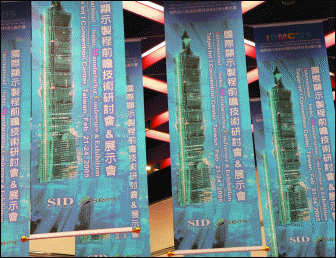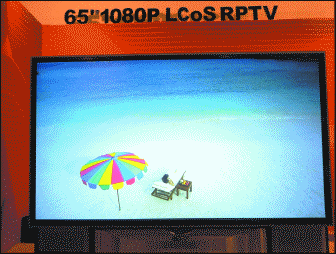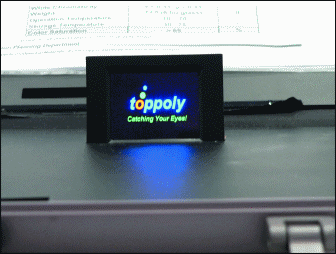Taiwan Display R&D Comes into Its Own at IDMC '05
No longer content with being efficient manufacturers of display technologies developed in Japan, Taiwanese display companies are developing their own solutions and placing them into production.
by Ken Werner
THE 2005 International Display Manufacturing Conference (IDMC '05), held in Taipei, Taiwan, February 21–24, 2005, was less about manufacturing technology than it was about the emergence of Taiwan's display companies as mature players on the world stage, willing and able to do battle with their Korean and Japanese competitors (Fig. 1).
It was only a few years ago that Taiwan's first TFT-LCD manufacturing lines were built, with each of Taiwan's nascent TFT-LCD companies associated with a Japanese partner. The Japanese partner transferred its manufacturing technology to the Taiwan company and often had preferred access to the panels that were produced.
Although Japan's dominance in TFT-LCD manufacturing passed to Korea and Taiwan several years ago, Japan still supplied its Taiwan partners with materials and components, which are projected to make up 50% of the 2007 cost of a 32-in. TFT-LCD made on a Gen 4.5 line (which uses a 730 x 920-mm substrate) and 68% of the 2007 cost of a similar panel made on a Gen 7 line (1870 x 2200 mm). These figures came from the Materials Research Laboratories of Taiwan's Industrial Technology Research Institute (MRL/ITRI) and were presented at the keynote session by Jong-Min Liu, General Director of MRL/ITRI and Chair of the Taiwan Flat Panel Display Materials & Devices Manufacturers Association (TDMDA).
Such statistics have led to a clear understanding that manufacturing efficiency by itself is not enough to attain the cost-down – the expression universally used in the Asian display-manufacturing community for cost reductions – needed if LCD TV is to be a sufficiently mass-product to justify the manufacturing capacity of Taiwan's (and Korea's) new Gens 6 and 7 manufacturing facilities. Equally important are competitive sources of materials and components that are less expensive now and will continue to get increasingly less expensive in the future.
 Ken Werner
Ken Werner
Fig. 1: Banners were hung from the lobby ceiling in the Taipei International Convention Center, celebrating the opening of IDMC '05.
For that reason, Taiwan has made it a national goal to develop a complete domestic TFT-LCD infrastructure. Liu said that Taiwan is now 65% self-sufficient in glass substrates, 60% in color filters, 55% in polarizers, 97% in backlight modules, and 74% in driver ICs.
This domestic activity has fueled a boom in display R&D that is new to the island, where technology companies have traditionally thought of themselves as skillful and efficient manufacturers, but not as innovators. In the presentations at IDMC '05, and in conversations held during the week, this new confidence in Taiwan's ability to feed its display industry through home-grown innovations was evident.
The R&D can be separated into two classes. The first, and by far the largest, is in support of the TFT-LCD industry. As Liu put it, "Taiwan is happy that it bet big on TFTs and won and is now the cost leader."
But there is also significant activity in projection technology and in possible alternatives to TFT-LCDs, such as OLEDs. First, let us look at some highlights of the LCD-related R&D activities discussed during the week of IDMC.
LCD-Oriented R&D
Chun-Ting Liu, speaking for a large team from the AU Optronics Technology Center, said that better color simulation tools are needed for large LCDs to enable more accurate prediction of color performance and more productive work on color image processing for LCD TVs. These enhanced tools must include the effects of the polyimide alignment layers and the LC material, as well as the effects of liquid-crystal electro-optics and the matrix color filter. Enhanced tools developed at AU Optronics Corp. come much closer to reality – with the predicted NTSC ratio within 3% of the actual display and chromaticity within 0.01 units, Liu said.
The more precise simulations revealed that tuning the green phosphor in the backlight's cold-cathode fluorescent lamps (CCFLs) is important for optimizing the NTSC ratio. An optimized CCFL can produce a color gamut of 96% of the traditional NTSC standard, while most current TFT-LCDs with CCFL backlights have a color gamut in the vicinity of 73% NTSC. By using an LED backlight, tuning the color filter to match the LED's output can improve the blue even more (Fig. 2).
Among the other areas of improvement that derive from this simulation work are dark state, contrast ratio, dark color performance, color-temperature and gamma calibration, and dynamic contrast adjustment. Liu emphasized that the improved understanding of color performance feeds into ever-more-sophisticated color image processing.
Liu concluded by saying, "All of the companies are working on color image processing, and I believe we will see substantial improvements."
Optically Compensated Bend LCD Mode. In their effort to make an LCD panel without motion blur, display designers have been attracted to the inherently fast optically compensated bend (OCB) LCD mode. Samsung has shown impressive OCB technology demonstrators on the show circuit for several years, and Taiwan's manufacturers have clearly been paying attention. AUO's Jeng-Fang Wu and his colleagues described a 17-in. SXGA OCB-LCD with 5-msec response time, 300:1 contrast ratio, and a NTSC ratio of 68%. By optimizing cell conditions, the authors said, performance of the display was improved to commercial grade.
Hui-Wen Yang and his co-authors from Chi Mei Optoelectronics (CMO) went one step further and incorporated black-image insertion into their 17-in. SXGA OCB-LCD. The response time of each cell from any gray state to black is less than 1 msec. If a black image is inserted, the transition to the next frame starts with each pixel being black, and the transition time from black to any gray level in this OCB-LCD display is between 1 and 4 msec without overdriving techniques. The result was the virtual elimination of motion-picture blur and the attaining of near CRT quality – although the OCB mode is very fast on its own, a small amount of motion-picture blur was still visible without the black-image insertion.
 Ken Werner
Ken Werner
Fig. 2: AU Optronics Corp. exhibited this 23-in. WUXGA (1920 x 1200) TFT-LCD panel with an LED backlight and an NTSC ratio of 100%. Colors were strikingly more saturated than on a typical TFT-LCD having a CCFL backlight; the Luminance is 200 nits, the contrast ratio is 700:1, and the response time is 8 msec (gray to gray).
In comparison testing, the authors reported that even with black-image insertion, motion blur could still be seen in an IPS display because of its slow LC response, and a double-edge effect could be seen slightly in a TN display because the optical response of the black state was not quick enough and the white state could not be driven to saturation in time.
Thin-Film Transistors. In the making of low-temperature polysilicon (LTPS) for thin-film transistors (TFTs), a-Si is annealed with lasers to make larger crystalline regions that line up in ways that improve the electron mobility of the material. Various approaches to this process were described at IDMC '05 by teams from Japan, the U.S., Hong Kong, the U.K., and The Netherlands, as well as Taiwan.
But regardless of the fabrication approach, all LTPS TFTs have grain boundaries that are between the individual crystalline regions. Hung-Tse Chen and a group of his colleagues from the Electronics Research and Service Organization of Taiwan's Industrial Technology Research Institute (ERSO/ITRI) studied the change in TFT characteristics when a grain boundary was or was not located in the TFT channel. TFTs with no grain boundaries in the channel had higher mobility, lower threshold voltage, and lower sub-threshold swing than those with one grain boundary in the channel. But TFTs with one grain boundary in the channel tolerated hot-carrier stress much better.
Whether it ultimately turns out to be more beneficial to have the grain boundary in the channel or outside of it, it would clearly improve TFT consistency if there were a practical production process that allowed for the unrestricted placement of the boundary. Huang-Chung Cheng and a team from the National Chiao Tung University and the Taiwan Vacuum Society described a method for "location-controlled grain growth" using a-Si spacers that act as the seeds for lateral grain growth during the laser annealing process. The result is large grains of crystalline silicon that can be positioned so there is no grain boundary in the TFT channel. The field-effect mobility of this material was 367 cm2/V-sec, compared to 128 cm2/V-sec for a conventional process.
LCOS Projection
In "The Competitive Power of LCOS," Tony Whitehead, Director of Technology Development with United Microdisplay Optronics (UMO) in Taiwan, made the case that liquid-crystal–on–silicon (LCOS) microdisplays are re-establishing themselves in the projection market, with emphasis on high-end three-panel rear-projection TV sets and monitors.
But LCOS has been tried in the market before, with a general lack of success. Why is it different this time? Whitehead faced this question head on, with a list of critical differences.
First, there are successful LCOS RPTV products on the market now, specifically the Sony Qualia 006 1080p rear-projection RPTV and 61- and 52-in. JVC 720p RPTVs. These high-end products are in stores now, and all have been very favorably received by critics and analysts. The Syntax Olevia 50-in. 720p RPTV is also available at a more modest price point.
In addition, LCOS-panel manufacturing and reliability are now mature, and the optical engine infrastructure is rapidly maturing. Color management is excellent, Whitehead said, and pre-designed optical cores allow quick market entry for manufacturers (Fig. 3). He commented that more than 20 companies are both co-operating and competing to develop an LCOS merchant market.
In the Q&A period, Information Display asked, "What has happened to improve the consistency of panel manufacturing?" Whitehead answered that the old model was to treat the LCOS imager as a scaled-down LCD, but that turned out to be hard because new problems grew out of the small size. "We brought in our semiconductor group to integrate LC and semiconductor processing. It took about one and a half years. Now, semiconductor processing is used throughout to make the imagers."
A New LCOS Light Source
Shau-Yu Tsai and his co-authors from the National Taiwan University of Science and Technology and Cinetron Technology proposed an LED-based light source for improving the saturation and uniformity of the color primaries in LCOS-projector light engines.
 Ken Werner
Ken Werner
Fig. 3: Among the companies entering the LCOS RPTV market is Chunghwa Picture Tubes, Ltd., which exhibited this good-looking 65-in. unit at IDMC. In addition to a pixel format of 1920 x 1080p, the receiver features motion-adaptive de-interlacing, pixel-to-pixel warping technology, a 3-D comb filter, a luminance of 600 nits, a contrast ratio of 1000:1, and an NTSC ratio of 75%.
In comparison with the high-intensity discharge lamps that are used with LCOS projectors today, LEDs offer wide color gamut, adjustable white point, wide dimming range, and very long lifetime. They are, in addition, mercury-free. Unfortunately, LEDs vary considerably in their optical and electrical performance, which has lead to non-uniformity in the illumination of the screen when LED arrays have been used as projection light sources. What is needed is an optical system that thoroughly mixes the light from the LEDs in the array, thus assuring uniformity.
What Tsai and his colleagues proposed and simulated are three multi-LED arrays, each of a different primary color, shining through lenslet arrays into an X-cube. The output of the X-cube passes through condenser lenses and a rod integrator, which serves as a critical second stage in the light mixing. A third stage may also be necessary, and this has been made part of the simulation.
If this system is used as the illuminator for single-panel LCOS projectors, the RGB LED arrays are switched sequentially and synchronized with the panel addressing. This makes the conventional color wheel unnecessary and eliminates its large light losses.
The system was carefully modeled in the ray-tracing program TracePro, which predicted an irradiance variation of less than 5%.
A Contrarian View
MRL/ITRI's Jong-Min Liu had said "Taiwan is happy that it bet big on TFTs and won and is now the cost leader." And it is clear that most of the participants in Taiwan's display industry agree.
But Jacob W. Lin, former President and CEO of the successful Taiwan LCD manufacturer Picvue, who is now heading ITRI's FPD Manufacturers Forum, has a different perspective. In a conversation with Information Display, Lin said that it is necessary to take a long-term view. "LCDs for TV still have many issues, including the cost and complexity of the backlight unit. For every LCD problem solved, five more are still pending. But it is not just a matter of specific technology problems and solutions, but of critical mass and ROI."
Lin calculates that TFT-LCDs will peak and decline before Gens 8 and 9 fabs come on line, a conclusion he was scheduled to share at the Global FPD Partners Conference in Okinawa the week following IDMC. At that conference, Lin planned to say to government and industry leaders that for a relatively small percentage of what is being spent on LCDs, OLEDs can take off. He supported the views expressed by Junji Kido in his keynote address and agreed that all of the major OLED issues could be resolved in only a few years.
But LCD issues are not solved, Lin said. They are too complex and full optimization is many years away. And Taiwan is in trouble if the anticipated LCD-TV boom does not take off as hoped because the huge investment in LCD capacity depends on it.
Lin was not alone in his enthusiasm for OLEDs. Five sessions at IDMC were devoted to the subject, and Toppoly showed its high-contrast 2.5-in. 640 x 240 LTPS AMOLED with system-on-panel (Fig. 4) at the exhibition that wound its way through the lobby of the Taipei International Convention Center.
Wrap-Up
Over 1050 persons registered for IDMC 2005, about 400 more than registered for the previous IDMC, which was held in 2003. Two hundred of the registrants were from outside of Taiwan, making IDMC '05 a genuinely international event. IDMC '06 will be held February 13–16, 2006, in Daegu, Korea. •
 Ken Werner
Ken Werner
Fig. 4: Toppoly showed this 2.5-in. 640 x 240 LTPS AMOLED with system-on-panel. A contrast ratio of greater than 1000:1 and a luminance of 150 nits produced a striking image. Its NTSC ratio is greater than 60%.
Ken Werner is the Editor of Information Display
magazine. He can be reached at kwerner@sid.org.